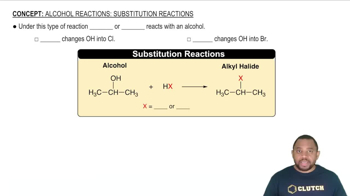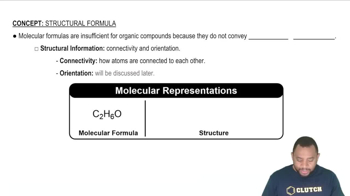Ch.22 - Chemistry of the Nonmetals
Chapter 22, Problem 89
Complete the exercises below. When aluminum replaces up to half of the silicon atoms in SiO₂, a mineral class called feldspars results. The feldspars are the most abundant rock-forming minerals, comprising about 50% of the minerals in Earth’s crust. Orthoclase is a feldspar in which Al replaces one-fourth of the Si atoms of SiO₂, and charge balance is completed by K⁺ ions. Determine the chemical formula for orthoclase.
 Verified step by step guidance
Verified step by step guidance1
Identify the chemical formula of SiO₂, which is the base structure for feldspars.
Recognize that in orthoclase, aluminum (Al) replaces one-fourth of the silicon (Si) atoms in SiO₂.
Calculate the number of Si atoms replaced by Al in the formula unit. Since one-fourth of the Si atoms are replaced, the formula becomes (Si₃Al)O₈.
Understand that the replacement of Si⁴⁺ by Al³⁺ creates a charge imbalance, which is compensated by the addition of K⁺ ions.
Combine the components to form the chemical formula for orthoclase: KAlSi₃O₈.
Key Concepts
Here are the essential concepts you must grasp in order to answer the question correctly.
Ionic Substitution
Ionic substitution occurs when one ion in a mineral's structure is replaced by another ion of similar size and charge. In the case of orthoclase, aluminum (Al³⁺) replaces silicon (Si⁴⁺) in the SiO₂ framework. This substitution is crucial for understanding how the mineral's composition changes while maintaining overall charge balance.
Recommended video:
Guided course

Alcohol Reactions: Substitution Reactions
Charge Balance
Charge balance is a fundamental principle in chemistry that ensures the overall charge of a compound is neutral. In orthoclase, the replacement of Si⁴⁺ by Al³⁺ creates a positive charge deficit, which is compensated by the inclusion of potassium ions (K⁺). This concept is essential for determining the correct stoichiometry of the mineral's formula.
Recommended video:
Guided course

Formal Charge
Chemical Formula Representation
A chemical formula represents the types and quantities of atoms in a compound. For orthoclase, the formula is derived from the ratio of aluminum to silicon and the presence of potassium ions. Understanding how to construct and interpret chemical formulas is vital for accurately describing the mineral's composition and properties.
Recommended video:
Guided course

Molecular Formula
Related Practice
